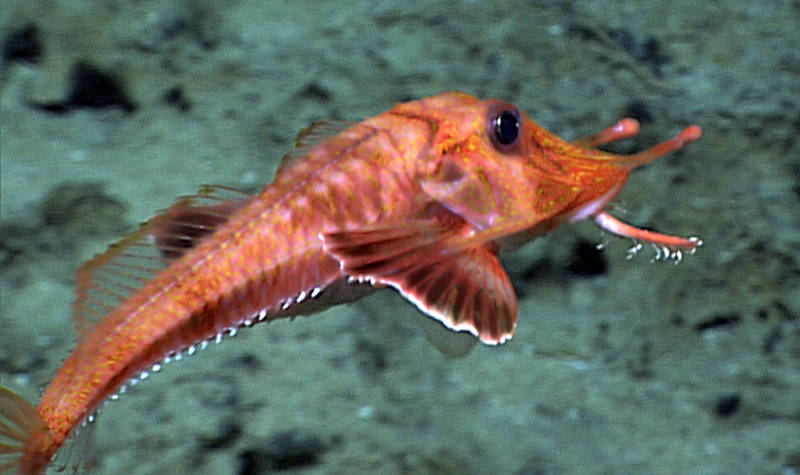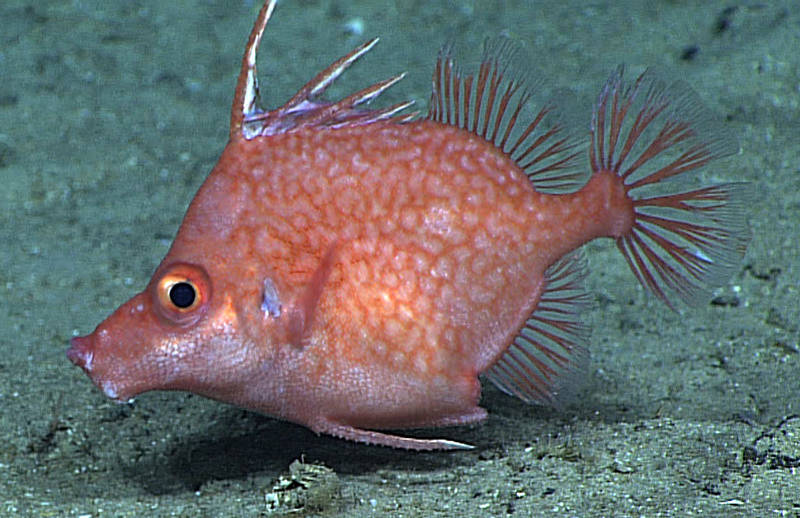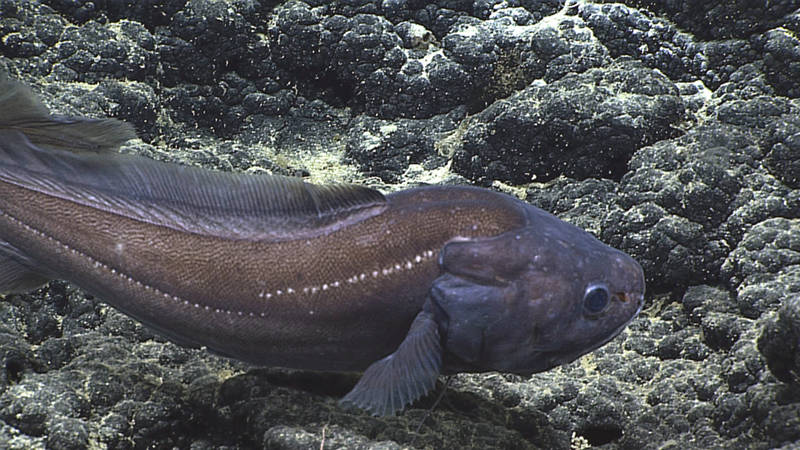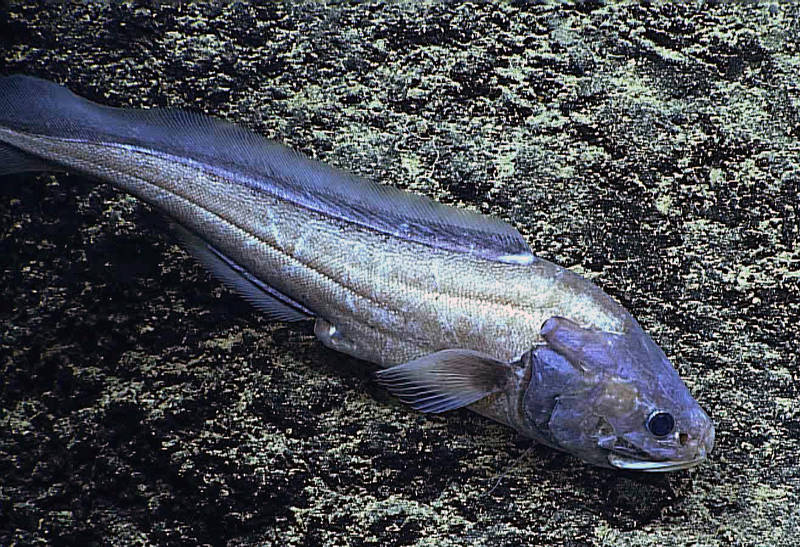Adapted from an essay by Bruce Mundy – Fishery Biologist, NOAA National Marine Fisheries Service, Pacific Islands Fisheries Science Center

Volcanoes created all of the seamounts and islands in the central Pacific Ocean. The coral reefs that we see now extend up into the sunlit shallow water, but are established on foundations of ancient, extinct volcanoes. The carbonate rock created by the reefs in the shallows does not extend to the deeper waters of most of the NOAA Ship Okeanos Explorer dives, which are between 500 and 6,000 meters. At these depths, we only see the lava flows from ancient, and not so ancient, volcanoes. Recent lava flows can be found at Hawaiʼi Island. A few of the ancient seamounts are even as old as the age of the dinosaurs (although the dinosaurs were never able to cross the Pacific Ocean to get to these Pacific islands and seamounts).
The fishes seen on all but the shallowest NOAA Ship Okeanos Explorer dives live in the habitats of these extinct volcanic lava flows – they are volcano fish. Some live near active volcanoes as well as on extinct features.
Lava Flows Bring New Fish to the Surface
Some deep-sea fish species were originally discovered from specimens found floating at the ocean surface – they lived in deep waters but were killed by lava flowing into the sea from eruptions of Mauna Loa volcano on Hawaiʼi Island. The famous ichthyologist David Starr Jordan, the original president of Stanford University, described that phenomenon for the first time in 1921. Most of the fishes that he reported had been described by others in earlier years, so many of the new names that Jordan coined for the species are no longer used. One that he mentioned, but did not describe as a new species, was later named for the volcano – the longtail slopefish Symphysanodon maunaloae.

In June 1950, another lava flow from Mauna Loa killed deep-sea fish, many of which were previously unknown. One of those killed was the strange Hawaiian spikefish, Hollardia goslinei, which has since been found to be very abundant.
New Insights About Cusk Eels

For me, some of the most interesting discoveries from NOAA Ship Okeanos Explorer have been cusk eels of the genus Diplacanthopoma, for the reasons described below.
Researchers discovered two species of Diplocanthopoma floating offshore of the 1950 Mauna Loa lava flow at Hoʼokena on the Kona coast. Dr. William Gosline the ichthyologist at the University of Hawaiʼi at the time, identified one of the species as Diplacanthopoma riversandersoni, which was first described in 1895 from the Arabian Sea; however, he was unable to name the second species. Diplacanthopoma species are livebearing fish in the family Bythitidae.
During the Hohonu Moana Expedition aboard NOAA Ship Okeanos Explorer, scientists observed two types of Diplacanthopoma. The Hawaiian Diplacanthopoma had never before been seen alive, and we knew nothing about their ecology. Now we know something about their habitat, including that they live in very deep water of at least at 1,096-1,380 meters (3,596-4,528 feet). What’s more, we now know that they are found not only off Hawaiʼi Island at the southern end of the Hawaiian Archipelago, but also northwestward almost to the other end of the island chain, as well as at the Geologist Seamounts located west of Hawaiʻi Island.

Diplacanthopoma species in other parts of the world occur to depths of 1,640 meters (5,380 feet); those seen by ROV Deep Discoverer were living at the deep end of the known depth-range for the genus. This fact gives us a puzzle to solve; how did lava flows from the high volcano of Mauna Loa kill fishes living so deep?
Perhaps these species also occur in shallower water, like many of the other species found floating off of the Hawaiʻi Island lava flows. Or perhaps the lava flows and their other effects reach deeper depths than we realize.
In 1920, David Starr Jordan published this description of the early lava flow by Carl Carlsmith:
At the end of September, 1919, a lava flow started in the district of Kau on the island of Hawaii, and flowed to the sea through the land of Alika, which name was given to the flow to distinguish it from others. The lava was of a very fluid variety, and upon reaching the sea it built a tunnel for itself upon the floor of the ocean. The offshore water at this point is very deep, and within a hundred feet or more of the shore reaches a depth of at least 200 fathoms. On visiting the place in a native canoe on the night of October 1, I found that the subterranean tunnel was bursting at various points with heavy detonations and sending up thick clouds of steam. These clouds of steam were noticed by me as far as 2 miles from the point where the flow entered the ocean.1
In 1954, William Gosline and others wrote a similar account, adding:
Whenever a heavy surge of lava hit the sea, a large amount of steam rose from the surface. Between the peaks of the surges, at least during the later stages of the flow, the moving column of lava entered the sea quietly, unexpectedly resembling an escalator disappearing through the floor of a department store. Apparently the failure to cause surface steam at such times was due to the cooling and hardening of the outer layer of the lava column into a water-impervious shell through which the rest of the lava flowed. (Such conduits, now hollow and sometimes extending for distances of more than a mile, are well-known features of the Hawaiian terrestrial landscape.) Since the molten material flowed continuously without ever filling this shell, it can be assumed that the lava was breaking out somewhere below. Such outbreaks presumably produced steam explosions which could be felt even in a skiff anywhere near the flow. However, no steam from these assumed outbreaks ever reached the surface, nor was this to be expected unless they had been very large or very near the surface.2
They quoted others who said that a line of steaming water extended to sea for about half a mile from the place where the lava entered the ocean, which is over very deep water at Hawaiʻi Island. They suggested that the fishes might have been killed by direct effects of the lava, such as overheating or lethal chemicals in the flows. They also suggested that the fish might have been killed by indirect effects, such as being carried upward in vertical currents created by the hot lava or by the underwater volcanic explosions from the lava flow.
One thing is clear, it is better to be a volcano fish on an extinct volcano than on an active one.
1W. A. Gosline, V. E. Brock, H. L. Moore, and Y. Yamaguchi. 1954. Fishes killed by the 1950 eruption of Mauna Loa. I. the origin and nature of the collections. Pacific Science, vol. 8, page 23.
2D. S. Jordan. 1920. Description of deep-sea fishes from the coast of Hawaii, killed by a lava flow from Mauna Loa. Proceedings of the U.S. National Museum, volume 59, number 2392, page 643.

